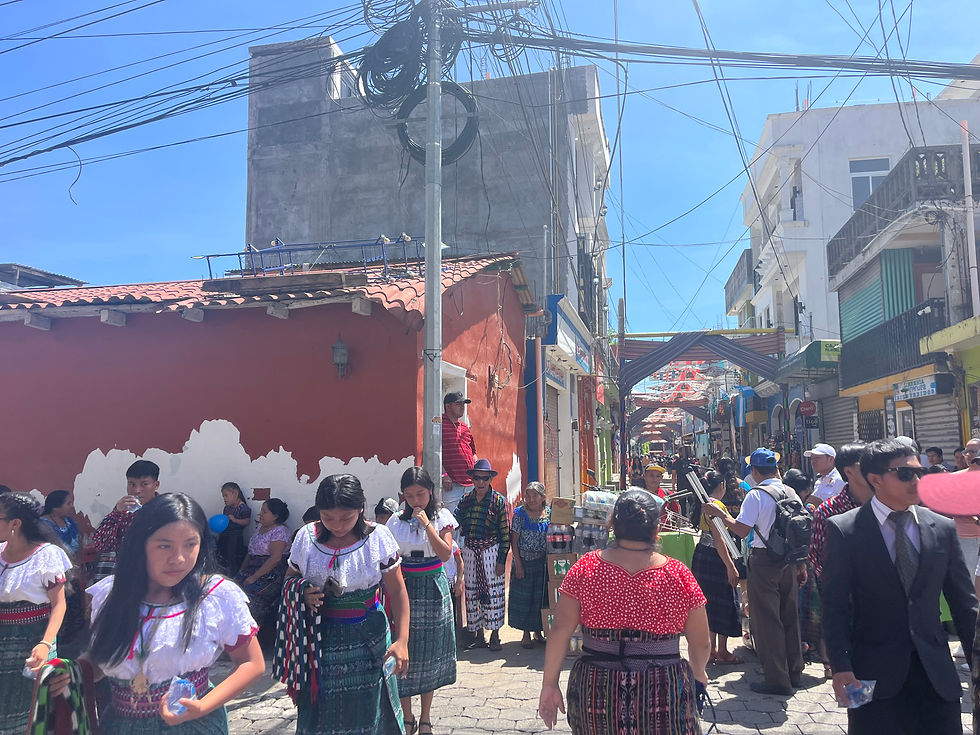A Town Frozen In Time & Indigenous Tourism Near The Panama Canal
- hptraveldiaries

- Jun 4
- 3 min read
Updated: Jul 28
Most travellers visit Panama City to island-hop San Blas, wander around Casco Viejo, or discover more about the Panama Canal. What they often miss is the opportunity to meet an indigenous community and see a historic town frozen in time; Gamboa.
Gamboa town was originally built in the 1930s to house the U.S. Canal Zone workers, but now it feels almost abandoned. When you drive through, it looks like the set of an American-style horror movie. This is because when the U.S. withdrew from the Canal Zone in 1999, many towns faded. Now, there is actually a big hotel - Gamboa Rainforest Reserve - which was once a government lodge, that now hosts visitors.
The marina nearby offers boat tours into Lake Gatun’s islands, specifically Monkey island, where monkeys often hop on board. But not only this, there are also organised boat tours to a village, where you can meet an indigenous community. This region has transformed into a small hub for eco-tourism - where tourists can see a hidden side of the Panama Canal.

Indigenous Village Tour
From the marina, a local drove us across the murky water, on a boat. Our guide claimed that the river is a haven for crocodiles, so that we would avoid putting our hands in. We could only hear the noises of the surrounding nature, and see a dense, green forest, as we ventured up-stream.

The river began to curve gently, narrowing in spots, exposing hidden lagoons and tangles of vines. Gradually amongst the mist, the village slowly emerged - its thatched roofs rose into view. As we approached the river’s edge, a small group of people stood waving, waiting to greet us.
The Emberá indigenous community lives here, in the heart of the rainforest. They protect their traditions and nature amid the echoes of modern change - not far from their village is the all-too-famous Panama Canal. For years, this community has not received the benefits of the Canal tourism. Today they sustain themselves with selling handmade crafts, guiding tours to their village and the jungle, and sharing their unique culture with outsiders who are interested.
We were welcomed into their home with open arms and taught about their daily life and years of history. They spoke to us about plant medicine, and their deep connection to the nature around them.
We followed one member of the community as he led us onto a narrow path just beyond the village, where the dense rainforest quickly swallowed the sunlight. Above us, there were towering trees, and around us the air felt thick. All we could hear was the slight hum of insects. In fact, we were swarmed by mosquitoes, and all continuously swatting. Meanwhile, our leader walked calmly ahead, untouched, as if the insects and him had an agreement. With a rustle of leaves he signalled that there was a monkey ahead, playing in the trees in the distance. With every step, it became clear that this place was more than just wilderness - it was the community's home. They don't just live in it, they live with it.
After this short and entrancing walk, we enjoyed a lunch of fish - caught fresh that morning - and patacones (fried plantains), as well as a selection of fruit. Instead of ordinary plates, the food was wrapped in large green leaves - a sustainable alternative. Once we'd finished eating, they started playing some traditional music and we watched as the whole community - young and old - came together to dance.
Why it's important to visit places like Gamboa
It's more than another tourist hotspot, it demonstrates Panama’s layered identity. Here, you’ll uncover glimpses of history, including the American influence, as well as tropical biodiversity, indigenous traditions and wisdom, and ongoing conservation efforts.
The Canal is not just an engineering marvel, it's also part of a living ecosystem. This nature experience, combined with cultural elements, sheds light on the traditional lifestyles that stand the test of time. It helps outsiders to understand the value of cultural preservation in the face of Panama's modernisation.
For me, one of the reasons I love to travel is because I believe in the power of cross-cultural connection, and that each culture has something to teach one another. A community like this, tucked away from modern life, has so much to teach us about how we can better protect and respect nature, and also the significance of tradition.
While millions of tourists visit Panama City and take time to visit the canal, few really slow down and listen to the stories of the local people who have witnessed all the changes in the area and their impact. Those who live peacefully amongst the trees, but have countless stories waiting to be shared.



















Comments